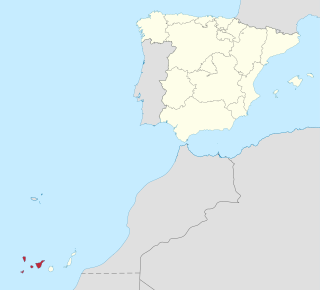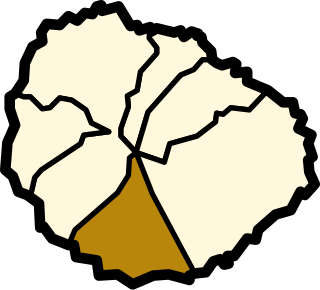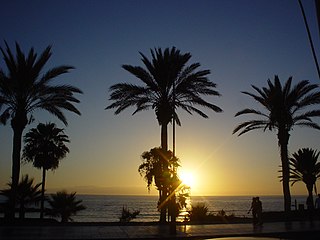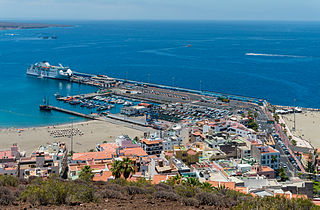
The Canary Islands, also known informally as the Canaries, are a Spanish autonomous community and archipelago in Macaronesia in the Atlantic Ocean. At their closest point to the African mainland, they are 100 kilometres west of Morocco and the Western Sahara. They are the southernmost of the autonomous communities of Spain. The islands have a population of 2.2 million people and are the most populous special territory of the European Union.

Province of Santa Cruz de Tenerife, also Province of Santa Cruz, is a province of Spain, consisting of the western part of the autonomous community of the Canary Islands. It consists of about half of the Atlantic archipelago: the islands of Tenerife, La Gomera, El Hierro, and La Palma. It occupies an area of 3,381 km2 (1,305 sq mi). It also includes a series of adjacent roques.

Tenerife is the largest and most populous island of the Canary Islands. It is home to 43% of the total population of the archipelago. With a land area of 2,034 square kilometres (785 sq mi) and a population of 978,100 inhabitants as of January 2022, it is also the most populous island of Spain and of Macaronesia.

Arguineguín is one of the most populated towns along the south coast of Gran Canaria, Spain. A once typical Canarian fishing village, it is now home to both locals and tourists, as the settlement has continued to grow. In 2015 it had 2517 inhabitants. It is part of the municipality of Mogán and is located southwest of Las Palmas.

Santa Cruz de Tenerife, commonly abbreviated as Santa Cruz, is a city, the capital of the island of Tenerife, Province of Santa Cruz de Tenerife, and one of the capitals of the Canary Islands, along with Las Palmas. Santa Cruz has a population of 206,593 (2013) within its administrative limits. The urban zone of Santa Cruz extends beyond the city limits with a population of 507,306 and 538,000 within urban area. It is the second largest city in the Canary Islands and the main city on the island of Tenerife, with nearly half of the island's population living in or around it.

Puerto del Carmen is the main tourist town on the island of Lanzarote, Canary Islands, Spain. It is part of the municipality of Tías. Most of Lanzarote's over 1 million visitors per year choose this town as their destination. As a result, almost all of the town's economy revolves around tourism.

Arona is a municipality in the southern part of the island of Tenerife in the Canary Islands, Spanish region and archipelago in the Atlantic Ocean, in Macaronesia. The municipality covers an area of 81.79 square kilometres comprising 4% of the island's area. The town of Arona is 59 km southwest of Santa Cruz de Tenerife, the island's capital. The population in 2017 was about 93,496. It is the third largest city in Tenerife, after, Santa Cruz de Tenerife and San Cristóbal de La Laguna. Arona has a pleasant climate with temperatures ranging from 20 to 25 degrees Celsius. Notable places include the tourist resorts of Los Cristianos, Playa de las Americas, Costa del Silencio and Las Galletas. Arona also features Punta Salemas, the southernmost point of the island of Tenerife. The TF-1 motorway passes through the municipality.

A cabildo insular is the government and administration institution of each of the seven major islands in the Canary Islands archipelago: Tenerife, Fuerteventura, Gran Canaria, Lanzarote, La Palma, La Gomera and El Hierro. The island of La Graciosa falls under the jurisdiction of the cabildo of Lanzarote.

Adeje is a town and municipality in the southwestern part of the island of Tenerife, one of the Canary Islands, and part of the province of Santa Cruz de Tenerife, Spain. The town Adeje is located 4 km from the coast, 8 km north of the resort town Los Cristianos, 60 km southwest of the island capital Santa Cruz de Tenerife and about 17 km northwest of Tenerife South Airport.

Alajeró is a municipality on the island of La Gomera in the province of Santa Cruz de Tenerife in the Canary Islands. It is located on the south coast, SW of the capital San Sebastián de la Gomera. As well as being a municipality, Alajeró is also the name of the administrative town that governs that municipality.

Playa de las Américas is a purpose-built holiday resort in Tenerife, one of the Canary Islands of Spain. It is located in the southern and southern-west part of the Municipality of Arona, close to the adjoining Municipality of Adeje in the west of Tenerife. It was built in the 1960s a few miles distant from the fishing village of Los Cristianos. Playa de las Americas now (2021) is part of the contiguous touristic construction zone lining Tenerife's entire southwestern coast. The resort area features bars, nightclubs, restaurants, attractions, and beaches, most of which are man-made with imported sand from Africa due to the darkness of the native volcanic sand. Playa de las Americas is a centre of nightlife in Tenerife. Nightlife is spread around the resort and includes the Veronicas Strip, Starco Commercial Centre and the Patch.

The flag of the Autonomous Community of the Canary Islands is a vertical tricolour of three equal bands of white, blue, and yellow. The state flag includes the Coat of arms of the Canary Islands in the central band; the civil flag omits this. The designs were made official by the Statute of Autonomy of the Canarian Autonomous Community on 16 August 1982.
Fred. Olsen Express is an inter-island ferry service based in the Canary Islands, Spain. It operates a fleet of six modern fast ferries on five routes. Its fleet includes a trimaran fast ferry, the Benchijigua Express, which was the first such vehicle in the world when it entered service in 2005. The company is owned by the Olsen family-controlled Bonheur and Ganger Rolf, which among other things also owns the shipping companies Fred. Olsen Cruise Lines and First Olsen Tankers.

The TF-1 is a motorway encircling the eastern and the southern parts of the island of Tenerife. The TF-1 motorway runs from the capital Santa Cruz in the north to Adeje with its major tourist resorts Los Cristianos and Playa de las Américas in the south of the island, and continues to Santiago del Teide in the west. It is a 103 km motorway and interchange numbers go facing south. The motorway is one in the Canary Islands that passes through most of the municipalities and is the longest in the archipelago as well.
Corralejo is a town and resort located on the northern tip of Fuerteventura, one of the Canary Islands, facing the smaller islet of Lobos. It is in the municipality of La Oliva. It is surrounded to the north and east by the Atlantic Ocean, by dunes to the south and by arid desert land to the west that leads to the western coast and El Cotillo. Once a traditional fishing village, the town has grown significantly and today is one of the two main tourist towns on the island of Fuerteventura. Thanks to the large expat population, the town has a diverse population that varies from the local Spaniard, to the Italian, Irish, British, German and Finnish people who have settled in the resort.
Tourism is an essential part of the economy of the Canary Islands, a Spanish archipelago located in the Atlantic Ocean, 100 kilometres west of Morocco. Seven main islands and six islets make up the Canary Islands. They had more than 9 million foreign incoming tourists in 2007. Tourists seeking sunshine and beaches first began to visit the Canaries in large numbers in the 1960s. The Canary Islands are a leading European tourist destination with very attractive natural and cultural resources.

The Port of Santa Cruz de Tenerife in Santa Cruz de Tenerife, is used by fishing boats, commercial and passenger ships, and sports. Located on the Atlantic Ocean, it is managed by the Port Authority of Santa Cruz de Tenerife, who also manage all commercial and leisure ports of the Province of Santa Cruz de Tenerife. Next to this port is the famous building of the Auditorio de Tenerife.

Puerto de la Cruz is a city and municipality in the northern part of the island of Tenerife, Canary Islands, Spain. It was formerly known by its English translation, "Port of the Cross", although now it is known by its Spanish name in all languages. Puerto de la Cruz is located on the northern coast, 4 km (2 mi) northwest of La Orotava and 30 km (19 mi) west of Santa Cruz de Tenerife. The TF-5 motorway passes through the municipality. The population is 30,483 (2018). In Spanish, the local inhabitants are known as Portuenses. With an area of 8.73 km2 (3 sq mi), the municipality is the smallest in Tenerife. The elevation of the town's centre is 9 m (30 ft) above sea level and the highest point being Las Arenas, a volcanic cone with an elevation of 249 m (817 ft).

Playa Santiago is a small town on the south coast of the island of La Gomera in the Canary Islands. It is split between two municipalities, Alajeró and San Sebastian. The part within the municipality of Alajero is the largest settlement in that municipality, with about half the population.

The Port of Los Cristianos is a port of the Atlantic Ocean located in the town of Los Cristianos, in the municipality of Arona on the island of Tenerife. It is administered by the Port Authority of Santa Cruz de Tenerife. It is the port with the highest passenger and vehicle traffic in the Canary Islands, in 2007 it had 1,829,579 passengers, and 238,836 vehicles.

























